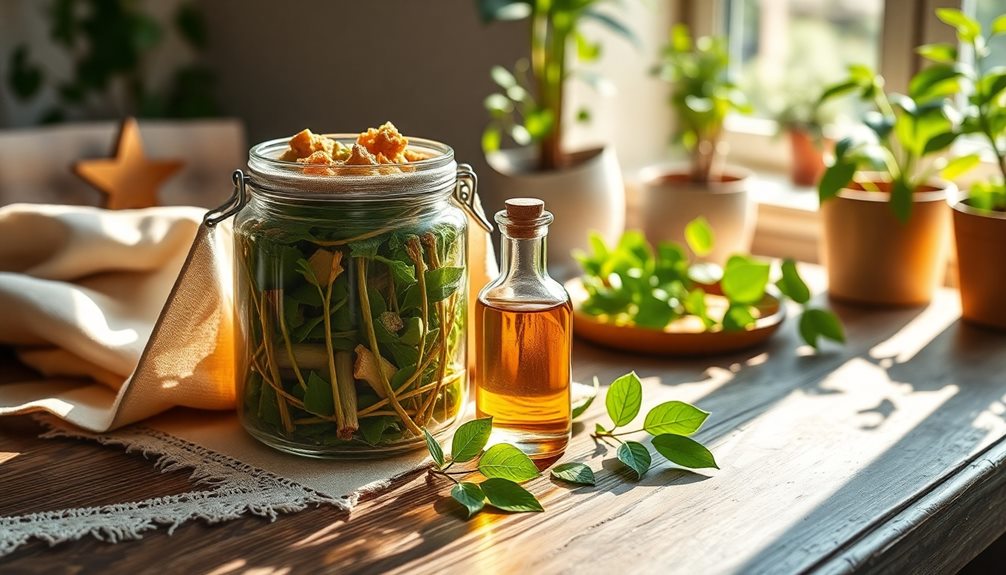Angelica root essential oil is a powerhouse for your health, offering benefits like easing menopausal symptoms and boasting potential anticancer properties. You can infuse it using carrier oils for topical applications or brew it in teas for a soothing drink. Always select fresh roots and be cautious with dosages, starting small to gauge your body's response. Remember, avoid it during pregnancy and consult a healthcare provider if you're on blood thinners. With its antimicrobial qualities and culinary versatility, this oil can enhance wellness in various ways. There's so much more to explore about its delicious uses and safety tips!
Summary
- Angelica root supports menopausal symptom relief, osteoarthritis treatment, and has anti-anxiety properties for relaxation and wellness enhancement.
- The essential oil exhibits antimicrobial effects, combating infections and supporting immune function against harmful bacteria and viruses.
- Infusion methods include steeping dried root in boiling water or using a carrier oil, with a recommended dosage of 500 to 2,000 mg per serving.
- Safety precautions include avoiding use during pregnancy, monitoring interactions with blood thinners, and being cautious of potential skin reactions.
- Sweeteners like honey or stevia can enhance the flavor of angelica-infused beverages while complementing its health benefits.
Anticancer Properties Against Glioblastoma
What if a natural remedy could hold promise against one of the most aggressive forms of brain cancer? Recent studies suggest that *Angelica sinensis*, commonly known as dong quai, may possess significant anticancer properties, particularly against glioblastoma cells.
Researchers have examined how compounds within angelica can inhibit tumor growth and promote cancer cell death. Additionally, incorporating essential oils such as clary sage, known for its calming properties, can enhance overall well-being and support your body's natural defenses Unlock the Calming Benefits.
The anticancer properties of angelica stem from its ability to modulate various biological pathways. It appears to enhance apoptosis, the process of programmed cell death, which is vital in combating cancer.
Additionally, *Angelica sinensis* may support immune function, helping your body fight off malignant cells more effectively.
Integrating angelica into your wellness routine could be beneficial. You might consider using it in teas or supplements, but always consult a healthcare professional before starting any new regimen.
Make sure you're aware of potential side effects, especially if you're on other medications.
While more research is needed to fully understand the extent of *Angelica sinensis*'s anticancer effects, its promise as a natural adjunct in the fight against glioblastoma is encouraging.
Stay informed and proactive about your health choices!
Antimicrobial Effects Observed
Many people may be surprised to learn that *Angelica archangelica* exhibits notable antimicrobial effects, making it a valuable addition to natural health practices.
Similar to cilantro essential oil, which also showcases antimicrobial properties, the essential oil derived from angelica root can help combat harmful bacteria and viruses, promoting overall health.
Research suggests that the essential oil derived from angelica root can help combat harmful bacteria and viruses, promoting overall health.
Here are three key benefits of the antimicrobial effects of angelica:
- Bacterial Inhibition: Studies show that angelica essential oil can inhibit the growth of various bacteria, including those responsible for infections.
- Antiviral Properties: Some research indicates that angelica may help in fighting viral infections, supporting your immune system.
- Wound Support: The antimicrobial properties can aid in wound healing by preventing infections, supporting the skin's natural recovery process.
Herbal Infusion Method
Creating your own essential oil from Angelica root is a rewarding process that allows you to harness the plant's aromatic and therapeutic properties. The herbal infusion method is a simple and effective way to extract the beneficial compounds from the dried root. This method involves steeping the Angelica root in a carrier oil, which absorbs the essential oils and extracts from the plant, resulting in a fragrant and versatile oil that can be used in various applications.
Similar to how chamomile essential oil is known for its calming effects, Angelica root offers its own unique soothing benefits, making this infusion a valuable addition to your wellness routine soothing properties of chamomile.
To begin, gather your ingredients and prepare your workspace. Make certain you have a clean, dry glass jar for infusing the oil and a suitable carrier oil, such as jojoba or sweet almond oil. The infusion process takes a few weeks, during which the oil will gradually take on the scent and properties of the Angelica root, making it perfect for aromatherapy, massage, or skincare.
Ingredients:
- Dried Angelica root
- Carrier oil (like jojoba or sweet almond oil)
Instructions:
Chop the dried Angelica root into small pieces and place them in a glass jar. Pour enough carrier oil over the root to completely submerge it. Seal the jar tightly and place it in a warm, sunny spot for about 2-3 weeks.
During this time, shake the jar gently every few days to help the infusion process. After 2-3 weeks, strain the oil through a cheesecloth or fine mesh strainer into a clean bottle, discarding the solid root pieces. Store the essential oil in a cool, dark place to preserve its potency.
Extra Tips:
When making your essential oil, confirm that the dried Angelica root is of high quality to maximize the benefits of your infusion.
Additionally, be aware that essential oils can be potent, so consider performing a patch test before applying the oil to your skin. If you're using the oil for therapeutic purposes, consulting with a qualified herbalist or healthcare provider is advisable to confirm safety and efficacy.
Infuse in Boiling Water
Infusing Angelica root in boiling water is a straightforward method that releases the herb's aromatic and therapeutic qualities. This process can be enhanced by combining it with other beneficial essential oils, such as caraway seed essential oil, known for its digestive support benefits.
To make your own angelica root tea, simply add one to two teaspoons of dried Angelica root to a cup of boiling water. Allow it to steep for about 10 to 15 minutes, then strain the herbs and enjoy. This infusion not only provides a soothing drink but also offers various herbal medicine benefits, such as supporting digestion and promoting relaxation.
If you're seeking a convenient alternative, consider angelica root supplements, which are available in capsules or tinctures. These can provide similar benefits without the preparation time required for tea.
However, always consult a healthcare professional before starting any new supplement regimen, especially if you're on medication or have health concerns.
Step 1. Select Fresh Angelica Root
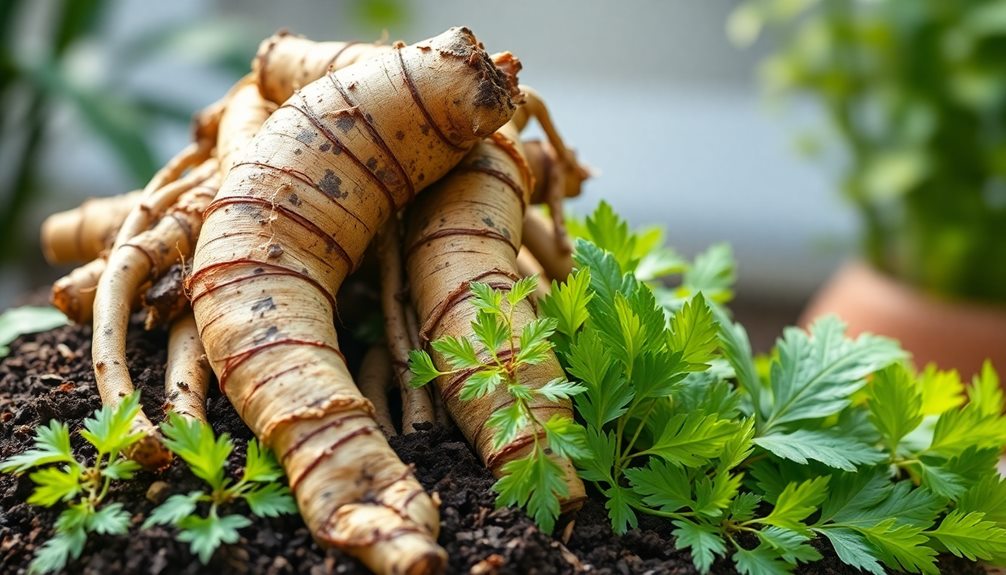
When you're looking to select fresh angelica root, it's important to choose high-quality specimens to maximize their benefits. Fresh angelica root offers a range of uses, from culinary applications to creating the essential oil of angelica. Its aromatic properties can enhance your experience, similar to how common sage essential oil is known for its calming effects.
To make certain you pick the best, keep these tips in mind:
- Look for Firmness: The root should feel solid and heavy, indicating freshness. Avoid roots that are soft or shriveled.
- Check for Color: A vibrant, pale to dark brown color signifies freshness. Dull or discolored roots may be past their prime.
- Smell the Aroma: Fresh angelica root has a distinct, earthy fragrance. If it lacks scent, it may not be fresh enough for your angelica root recipes.
Selecting quality angelica root enhances its benefits in various applications, from herbal remedies to making essential oil.
Step 2. Measure Root for Infusion
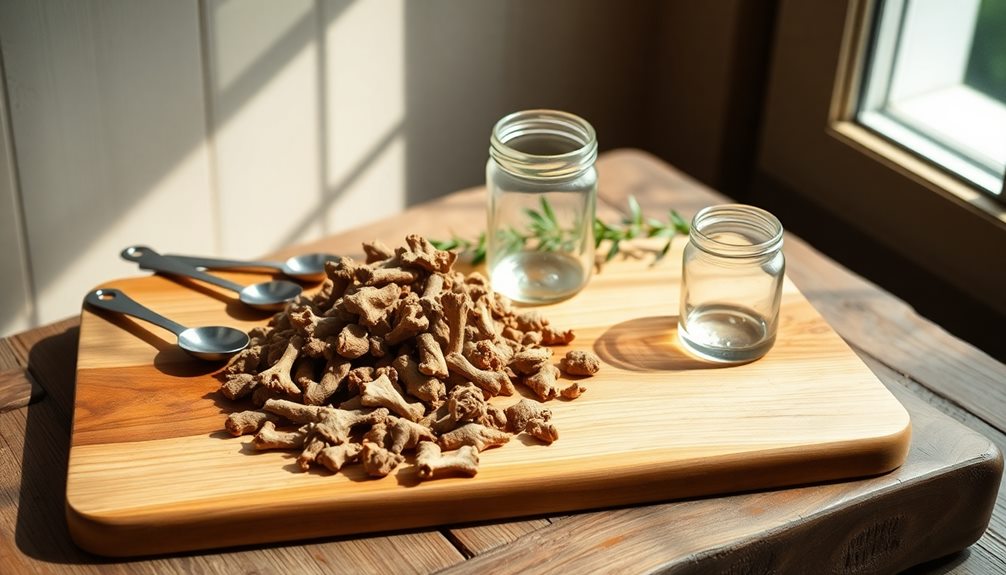
To effectively measure the root for infusion, you'll want to ascertain you're using the right proportions for maximum benefit. Start by considering the recommended angelica root dosage, which typically ranges from 500 to 2,000 mg per serving.
If you're making a tincture or oil infusion, you'll need about 1 ounce of dried angelica root for every 16 ounces of carrier oil or solvent. This ratio assures that you extract enough beneficial compounds without overwhelming your mixture. Additionally, combining it with other essential oils, like calming Balsam Fir, can further enhance its therapeutic effects.
When infusing, remember that aromatherapy with angelica can be quite potent. It's best to begin with smaller amounts and adjust based on your experience and preference.
Always keep in mind the safety of angelica during pregnancy; it's generally advised to avoid it since its effects on pregnant women haven't been thoroughly studied.
As you measure, make certain to use a precise scale or measuring cups for accuracy. This practice will enhance your infusion's effectiveness and maintain the integrity of the angelica root's properties.
Consistency is key to achieving the desired aromatherapy benefits, allowing you to enjoy the holistic advantages this root offers.
Step 3. Strain and Cool Infusion
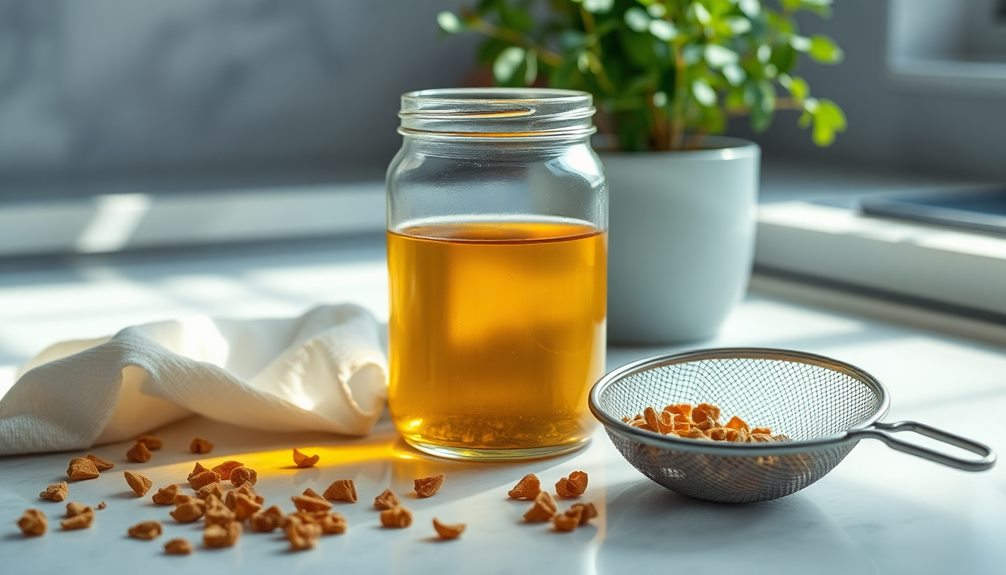
After measuring the right amount of dried angelica root for your infusion, it's time to strain the mixture and let it cool.
Straining is essential to guarantee you're left with a pure extract, free from any solid particles. This step allows you to enjoy the benefits of *angelica archangelica* without any gritty texture.
Additionally, similar to the extraction of other essential oils like agarwood, the quality of your infusion can considerably impact its therapeutic properties.
Here's how to proceed:
- Use a fine mesh strainer or cheesecloth: Place it over a clean bowl or jar to catch the liquid while filtering out the root pieces.
- Pour slowly: This helps prevent spills and guarantees you capture every drop of your infusion.
- Let it cool: Allow the strained liquid to sit at room temperature until it's cool to the touch. This is important for storage and will help maintain the integrity of your *DIY angelica essential oil*.
Step 4. Add Sweetener to Taste
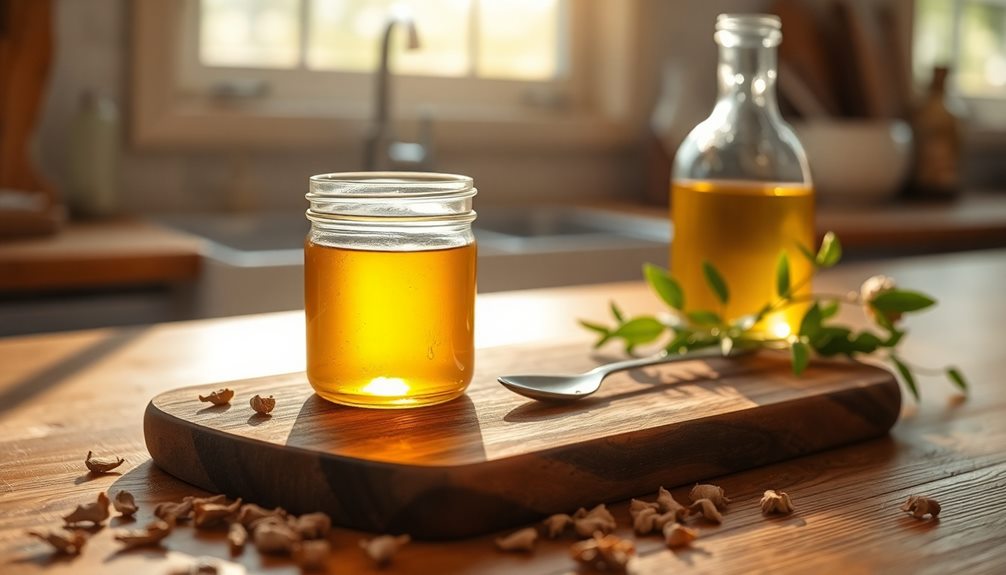
Enhancing the flavor of your angelica root infusion with a sweetener can make it more enjoyable and palatable. You can use honey, agave syrup, or even stevia to add just the right touch of sweetness. This not only improves the taste but can also complement the herb's natural benefits, including its anti-anxiety properties of angelica, making your drink both soothing and enjoyable.
Additionally, the uplifting effects of bergamot essential oil can further enhance your mood, creating a delightful experience overall while enjoying your infusion. uplifting and calming properties
When considering sweeteners, think about your dietary preferences and any potential health impacts. For instance, if you prefer a natural option, honey provides additional antioxidants, while agave offers a lower glycemic index. If you're looking for a calorie-free choice, stevia is your best bet.
Incorporating sweeteners into your angelica root infusion also highlights the culinary uses of angelica, as this herb has long been used in food and drink, from teas to liqueurs.
Remember, angelica sinensis, known as female ginseng, is particularly celebrated for its health benefits. So, as you enjoy your infusion, you're not only enhancing the flavor but also embracing a holistic approach to wellness.
Sweeten to taste, and savor the benefits!
Step 5. Consider Potential Health Risks

When exploring the benefits of angelica root, it's crucial to take into account potential health risks associated with its use. While it may aid in wound healing with angelica and support overall wellness, you should be aware of certain precautions.
Additionally, combining angelica root with other therapeutic agents, such as cannabis essential oils, can enhance its effects but may also introduce new interactions to bear in mind.
- Interactions with Blood Thinners: If you're on medications like warfarin, be cautious. Angelica root can increase bleeding risks due to its anticoagulant properties, so consult your healthcare provider before use.
- Potential Side Effects: Some individuals may experience skin reactions, particularly photodermatitis, when handling the herb. If you're sensitive, think about wearing gloves and limiting exposure.
- Safety During Pregnancy: The safety of angelica during pregnancy and breastfeeding isn't well-established. It's best to avoid it in these situations to prevent any potential harm to you or your baby.
Incorporating angelica root as part of your natural remedies for anxiety can be beneficial, but always prioritize safety.
Final Thoughts
Understanding the benefits and risks of angelica root can empower you to make informed choices about incorporating it into your wellness routine. Whether you're seeking menopausal symptoms relief or exploring options for osteoarthritis treatment, angelica root may offer valuable support. However, being aware of its potential side effects, like photodermatitis, is essential to guarantee your safety.
Here's a quick summary of the key points to take into account:
| Aspect | Details |
|---|---|
| Benefits | Menopausal symptoms relief, osteoarthritis treatment |
| Precautions | Risk of photodermatitis, interactions with medications |
Remember that everyone's body responds differently, so it's wise to consult with a healthcare professional before adding angelica root to your routine. Start with small doses and monitor how you feel. As you explore the world of herbal remedies, stay informed and attentive to your body's responses. By doing so, you can harness the potential of angelica root while minimizing risks, creating a balanced approach to your health and wellness journey.
FAQ
Can Angelica Root Be Used During Pregnancy or Breastfeeding?
You shouldn't use angelica root during pregnancy or breastfeeding, as safety isn't established. It's best to prioritize your health and consult a healthcare provider for safer alternatives and guidance during this vital time.
What Are the Possible Side Effects of Using Angelica Root?
Using angelica root can lead to side effects like increased blood pressure, potential heart issues, and skin reactions. It might interact with medications, especially blood thinners, so you should consult a healthcare provider before using it.
How Should I Store Angelica Root Essential Oil?
Store your angelica root essential oil in a cool, dark place, away from direct sunlight. Use an airtight glass container to preserve its potency and avoid heat exposure, ensuring it remains effective for future use.
Are There Any Known Drug Interactions With Angelica Root?
Yes, angelica root can interact with blood thinners, increasing bleeding risks. It's vital to consult your healthcare provider before using it, especially if you're on medications that affect blood pressure or clotting. Stay informed!
What Is the Recommended Dosage for Angelica Root Supplements?
For angelica root supplements, you might consider a dosage between 500 to 2,000 mg per serving. Always check the specific species and consult a healthcare provider to guarantee it's suitable for your needs.
